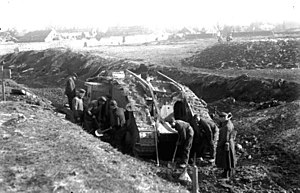Battle of Cambrai (1917)
| Battle of Cambrai 1917 | |||||||
|---|---|---|---|---|---|---|---|
| Part of the Western Front of the First World War | |||||||
 German soldiers recovering a British Mark IV tank |
|||||||
|
|||||||
| Belligerents | |||||||
|
|
|
||||||
| Commanders and leaders | |||||||
|
|
|
||||||
| Strength | |||||||
| 2 Corps 476 tanks (378 combat tanks) |
1 Corps | ||||||
| Casualties and losses | |||||||
|
c. 44,000 179 tanks |
c. 45,000 | ||||||
The Battle of Cambrai (called the Battle of Cambrai, 1917 by the Battlefield Nomenclature Committee; also sometimes referred to as the First Battle of Cambrai) was a British offensive and German counter-offensive battle in the First World War. Cambrai, in the Nord département (Nord-Pas-de-Calais), was an important supply point for the German Siegfriedstellung (known to the British as the Hindenburg Line) and capture of the town and the nearby Bourlon Ridge would threaten the rear of the German line to the north. Major General Henry Tudor, Commander, Royal Artillery (CRA) of the 9th (Scottish) Division, suggested trying out new artillery-infantry techniques on his sector of the front. During preparations, J. F. C. Fuller, a staff officer with the Tank Corps, was in the process of looking for a place to use tanks as raiding parties. General Julian Byng, commander of the British Third Army, decided to combine both plans into the attack.
...
Wikipedia
